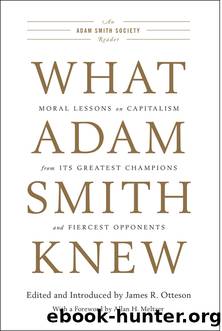What Adam Smith Knew by Otteson James;

Author:Otteson, James; [Otteson, James R; Meltzer, Allan H;]
Language: eng
Format: epub
Publisher: Encounter Books
JOSEPH A. SCHUMPETER
11.Capitalism, Socialism, and Democracy, 1942
Part II, Chapter 7: The Process of Creative Destruction
The theories of monopolistic and oligopolistic competition and their popular variants may in two ways be made to serve the view that capitalist reality is unfavorable to maximum performance in production. One may hold that it always has been so and that all along output has been expanding in spite of the secular sabotage perpetrated by the managing bourgeoisie. Advocates of this proposition would have to produce evidence to the effect that the observed rate of increase can be accounted for by a sequence of favorable circumstances unconnected with the mechanism of private enterprise and strong enough to overcome the latterâs resistance. This is precisely the question which we shall discuss in Chapter IX. However, those who espouse this variant at least avoid the trouble about historical fact that the advocates of the alternative proposition have to face. This avers that capitalist reality once tended to favor maximum productive performance, or at all events productive performance so considerable as to constitute a major element in any serious appraisal of the system; but that the later spread of monopolist structures, killing competition, has by now reversed that tendency.
First, this involves the creation of an entirely imaginary golden age of perfect competition that at some time somehow metamorphosed itself into the monopolistic age, whereas it is quite clear that perfect competition has at no time been more of a reality than it is at present. Secondly, it is necessary to point out that the rate of increase in output did not decrease from the nineties from which, I suppose, the prevalence of the largest-size concerns, at least in manufacturing industry, would have to be dated; that there is nothing in the behavior of the time series of total output to suggest a âbreak in trendâ; and, most important of all, that the modern standard of life of the masses evolved during the period of relatively unfettered âbig business.â If we list the items that enter the modern workmanâs budget and from 1899 on observe the course of their prices not in terms of money but in terms of the hours of labor that will buy themâi.e., each yearâs money prices divided by each yearâs hourly wage ratesâwe cannot fail to be struck by the rate of the advance which, considering the spectacular improvement in qualities, seems to have been greater and not smaller than it ever was before. If we economists were given less to wishful thinking and more to the observation of facts, doubts would immediately arise as to the realistic virtues of a theory that would have led us to expect a very different result.
Nor is this all. As soon as we go into details and inquire into the individual items in which progress was most conspicuous, the trail leads not to the doors of those firms that work under conditions of comparatively free competition but precisely to the doors of the large concernsâwhich, as in
Download
This site does not store any files on its server. We only index and link to content provided by other sites. Please contact the content providers to delete copyright contents if any and email us, we'll remove relevant links or contents immediately.
The Secret History by Donna Tartt(18056)
The Social Justice Warrior Handbook by Lisa De Pasquale(11930)
Thirteen Reasons Why by Jay Asher(8399)
This Is How You Lose Her by Junot Diaz(6401)
Weapons of Math Destruction by Cathy O'Neil(5779)
Zero to One by Peter Thiel(5444)
Beartown by Fredrik Backman(5293)
The Myth of the Strong Leader by Archie Brown(5204)
The Fire Next Time by James Baldwin(4986)
How Democracies Die by Steven Levitsky & Daniel Ziblatt(4932)
Promise Me, Dad by Joe Biden(4890)
Stone's Rules by Roger Stone(4818)
100 Deadly Skills by Clint Emerson(4647)
Rise and Kill First by Ronen Bergman(4527)
A Higher Loyalty: Truth, Lies, and Leadership by James Comey(4520)
The David Icke Guide to the Global Conspiracy (and how to end it) by David Icke(4348)
Secrecy World by Jake Bernstein(4342)
The Farm by Tom Rob Smith(4294)
The Doomsday Machine by Daniel Ellsberg(4220)
